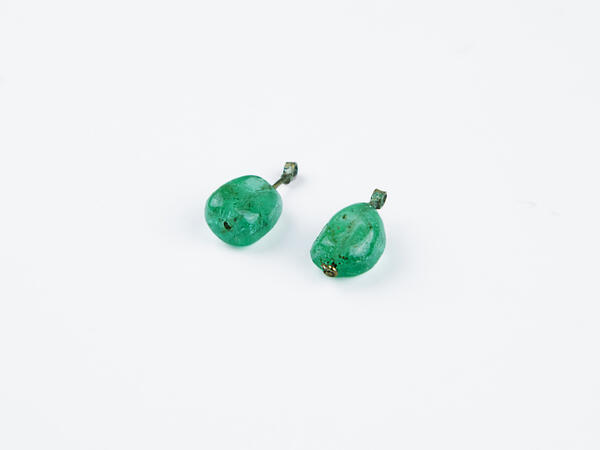Numerous fragments of a once luxurious dress of red silk with silver brocade galloon have been found in one of the burials of the Demidov family tomb in the Nicholas-Zaretsky Church. Not far from the dress lay remnants of pointed shoes of green silk embroidered with gold thread, and earrings of yellow metal shaped into a loop with odd-shaped oval beads of translucent green stone.
In the 19th century, Russian jewelry art developed within the framework of European tradition and practices, which was reflected in the assortment of jewelry, and in its stylistic connection to the main styles of the era — from Empire through all the “historical” styles (neo-Baroque, neo-Rococo, neoclassicism, etc.) to Art Nouveau. The fragments of earrings presented in the Historical and Memorial Museum of the Demidovs are a shining example of this historical dynamic.
The connection with European traditions was also manifested in the way production was organized, true to both small jewelry workshops and large jewelry companies like that of Carl Faberge, Pavel Ovchinnikov, Ivan Khlebnikov, the Grachev brothers, which were equipped with cutting-edge mechanical equipment and several craftsmen of various specialties on staff. These factories made a significant part of the overall volume of jewelry produced. They often based the design of their products on works done by famous artists. Jewelers who were not part of large enterprises were united in artels or small jewelry workshops. By the 19th century, individualistic jewelry production characteristic of the previous century almost ceased to exist.
In the late 1860s and early 1870s, it became fashionable to wear very large earrings. They were in most cases made of gold with precious stones and pearls for evening outings and enamel stones for wearing during the day. Earrings took the shape of tridents, spheres, openwork grids, drops, diamonds, crosses, rosettes, amphorae, rings, stars, flowers, and ovals with fringes. Along with custom-made expensive jewelry, large quantities of inexpensive jewelry for the mass consumer were also produced. By the second half of the 19th century, the artistic quality of local jewelry gradually decreased: local craftsmen could not compete with the big companies, and gradually switched to repairing and producing small jewelry.




